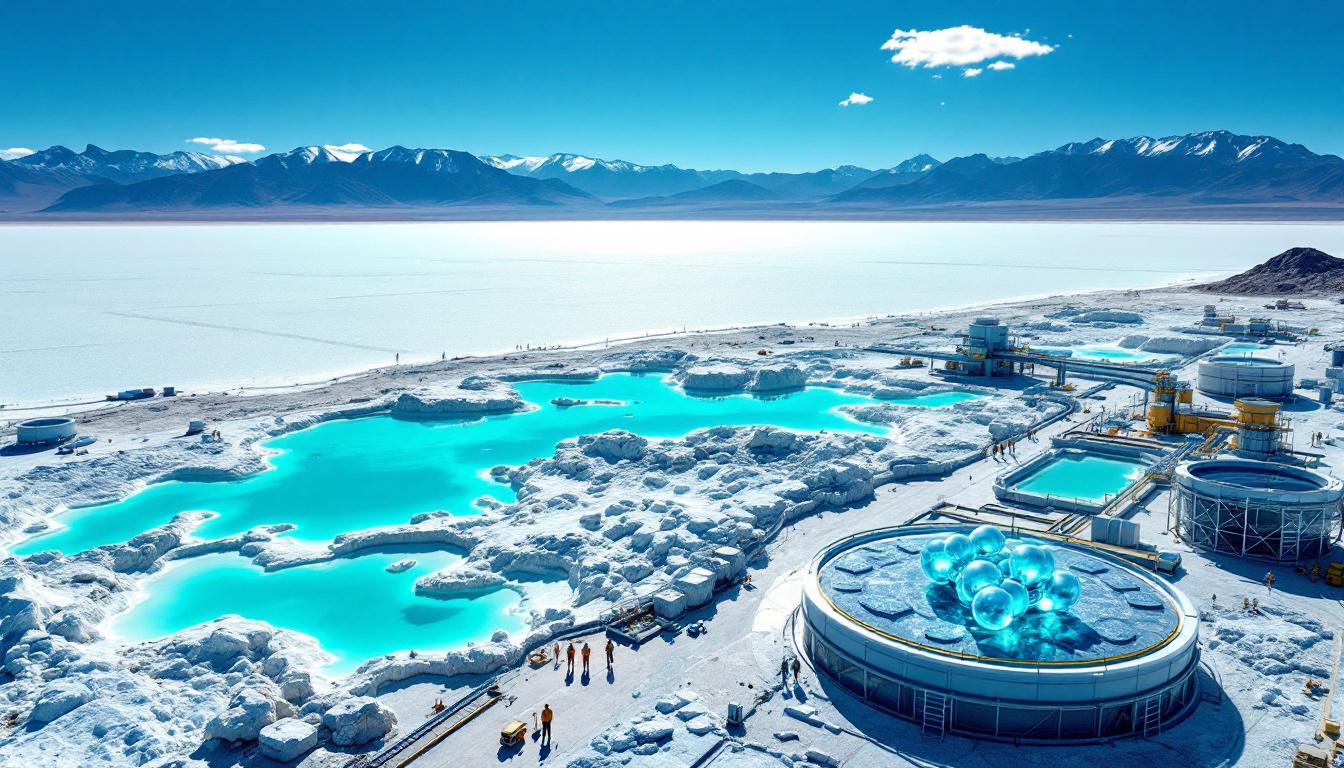Tharisa Reports Quarter-on-Quarter Increase in Chrome and PGM Production
Tharisa PLC, the platinum group metals (PGMs) and chrome co-producer, has reported encouraging production increases for Q1 2025 despite facing unprecedented weather challenges. The company's resilience in maintaining output levels amid adverse conditions demonstrates operational adaptability and strong fundamentals in its core mining operations.
What Are the Latest Production Results from Tharisa?
Q1 2025 Production Highlights
The first quarter of the 2025 financial year saw Tharisa produce 32,500 ounces of 6E PGMs, representing an 8.7% increase compared to the previous quarter (Q4 2024). This production includes platinum, palladium, rhodium, ruthenium, iridium, and osmium – all critical metals for various industrial applications including automotive catalytic converters and clean energy technologies.
Chrome concentrate production reached 381,000 tonnes, marking a 1.8% increase from the preceding quarter. This steady improvement in both PGM and chrome production demonstrates the company's operational efficiency despite challenging circumstances.
Year-on-Year Comparison
While the quarter-on-quarter figures show positive momentum, year-on-year comparisons reveal some challenges. PGM production decreased by 8% compared to Q1 2024, when the company produced 35,300 ounces. Similarly, chrome production saw a 5.4% decline from the 402,700 tonnes produced in the same period last year.
Industry analysts note that these year-on-year decreases should be viewed in context of the extraordinary weather events that have impacted mining operations across South Africa's Bushveld Complex, where Tharisa's flagship operation is located.
How Did Weather Impact Tharisa's Mining Operations?
Unprecedented Weather Challenges
The quarter experienced record rainfall that significantly affected both mining mix and production volumes. This precipitation led to higher-than-budgeted in-pit evacuations, which were necessary to maintain safety standards at the operation.
Lightning disruptions reached an all-time high during the quarter, forcing temporary halts in mining activities to protect personnel and equipment. These weather-related disruptions are unusual for the region's typically more predictable climate patterns.
In a statement, Tharisa CEO Phoevos Pouroulis noted that these weather events "dampened what was otherwise a solid quarter," highlighting the operational team's ability to maintain production increases despite these challenges.
Expected Recovery
The company anticipates that the upcoming dryer winter months will help normalize production output. Historically, the May to September period in South Africa's North West Province sees minimal rainfall, which should allow for more consistent mining operations and improved production efficiency.
Despite the Q1 weather challenges, Tharisa has maintained its full-year production guidance, demonstrating confidence in its ability to make up for any shortfalls in the coming quarters. This stability in guidance has been viewed positively by market analysts tracking the company's performance.
What's Happening with PGM and Chrome Market Prices?
PGM Price Trends
The average PGM basket price during Q1 2025 stood at $1,421 per ounce, showing positive momentum with a 2.9% increase from Q4 2024 ($1,381 per ounce) and a more substantial 5.8% increase from Q1 2024 ($1,343 per ounce).
This price recovery reflects ongoing market recalibration as supply-demand dynamics adjust following previous market imbalances. Industry experts note that industrial demand for PGMs is showing signs of stabilization, particularly from the automotive sector where PGMs remain critical for emissions control systems despite the growth in electric vehicle adoption.
A lesser-known factor influencing PGM prices is the growing demand from the hydrogen economy, where platinum plays a crucial role in electrolyzers and fuel cells. This emerging application could provide additional price support for specific PGMs in Tharisa's basket over the medium term.
Chrome Price Movements
Chrome prices have shown more volatility, with the average metallurgical-grade chrome concentrate price reaching $235 per tonne for Q1 2025. This represents a 13.3% decrease from Q4 2024 ($271 per tonne) and a 17.8% decrease from Q1 2024 ($286 per tonne).
However, recent market activity suggests a recovery is underway, with spot prices reaching approximately $300 per tonne. This rebound indicates strengthening demand from stainless steel producers, particularly in China, which consumes approximately 60% of global chrome supply.
Port stocks currently stand at approximately 6-8 weeks of inventory levels, which is considered relatively balanced by industry standards. This inventory position suggests that dramatic price swings may be limited in the near term, assuming stable demand patterns continue.
How Might Trade Tariffs Affect Tharisa's Markets?
Potential Market Impact
On April 2, 2025, the United States announced far-reaching trade tariffs on various imported goods, though implementation of some of these measures has subsequently been delayed. While PGMs and chrome are not directly subject to these US tariffs, there are potential secondary effects that warrant consideration.
Intermediate and final products containing these commodities will be affected by the tariff changes. For example, stainless steel products incorporating chrome may face import duties, potentially reducing demand for the underlying raw material. Similarly, automotive components containing PGMs could see price pressures if subject to tariffs.
The resulting uncertainty about the impact on global economic growth has created a volatile market environment. Analysts suggest that potential reduction in demand for motor vehicles – a key consumer of PGMs for catalytic converters – could affect PGM consumption patterns if trade tensions escalate further.
A unique industry insight suggests that South African PGM producers might actually benefit from certain trade restrictions if they limit competing supply from Russia, currently the world's largest palladium producer. This geopolitical angle adds another layer of complexity to market projections.
Market Stability Factors
Despite price fluctuations, chrome demand remains fundamentally strong, driven by continuing growth in global stainless steel production. Logistics pipelines for both chrome and PGMs are currently operating normally, facilitating smooth market function.
An often-overlooked factor providing some stability for South African producers like Tharisa is the recent rand devaluation against major currencies. This currency effect helps stabilize PGM basket prices in local currency terms, partially offsetting any dollar-denominated price pressures.
Mining industry experts note that South Africa's unique geological advantage – hosting approximately 80% of the world's known PGM reserves and substantial chrome deposits – provides companies like Tharisa with natural hedging against certain market fluctuations through their co-production model.
What Are Tharisa's Production Targets for FY2025?
Full-Year Guidance
Tharisa has maintained its full-year production guidance of 140,000-160,000 ounces of 6E PGMs and 1.65-1.8 million tonnes of chrome concentrate. This consistency in forward guidance, despite Q1 weather challenges, reflects management confidence in operational recovery during the remainder of the fiscal year.
The company's ability to maintain these targets is supported by ongoing operational improvements at its flagship Tharisa Mine, including investments in mining fleet optimization and processing plant efficiency enhancements. These technical improvements are expected to help increase recovery rates for both PGMs and chrome.
A critical factor in achieving these targets will be the grade profile of ore processed throughout the remainder of the year. Mining engineers note that accessing higher-grade reef sections in the coming quarters could significantly boost production metrics, potentially compensating for Q1 disruptions.
What Development Projects Is Tharisa Advancing?
Tharisa Minerals Underground Project
A definitive feasibility studies insights for Tharisa's underground mining project is on track for approval in the second half of 2025. This represents a significant strategic pivot for the company, which has historically focused on open-pit operations.
The company has indicated plans to update the market on what it terms "exciting plans" for this development later in the year. Industry specialists suggest this could involve innovative mining methods specifically adapted to the unique geology of the Bushveld Complex's PGM and chrome-bearing reefs.
Studies on the underground mine development are nearing finalization, with particular focus on optimal shaft placement and mining methods that maximize recovery of both PGMs and chrome. The co-production model that has defined Tharisa's operations will likely extend to this future of underground mining.
Geological assessments indicate that the underground extension could access ore bodies with potentially higher PGM grades than currently mined in the open pit, which could enhance the project economics significantly.
Karo Platinum Project (Zimbabwe)
Infrastructure work continues at the Karo Platinum Project in Zimbabwe, with progress aligned with available funding for work packages. This measured development approach reflects prudent capital allocation in the current market environment.
Value engineering efforts continue to optimize project economics, with technical teams focusing on maximizing resource utilization while minimizing capital expenditure. These optimization efforts could potentially improve the project's internal rate of return by several percentage points.
Industry observers note that the Karo project represents an important geographical diversification for Tharisa, reducing its operational concentration in South Africa. The Great Dyke geological formation in Zimbabwe, where Karo is located, contains significant PGM deposits with metallurgical characteristics that complement Tharisa's existing operations.
Regulatory developments in Zimbabwe's mining sector may also influence the project timeline, with recent policy changes aimed at attracting mining investments insights potentially creating a more favorable operating environment for international developers like Tharisa.
FAQ About Tharisa's Chrome and PGM Production
What are 6E PGMs?
6E PGMs refer to six platinum group metals: platinum, palladium, rhodium, ruthenium, iridium, and osmium. These precious metals have various industrial applications, particularly in automotive catalytic converters, electronics, jewelry, and increasingly in hydrogen technologies.
While platinum and palladium receive the most market attention, the other elements in the basket can significantly influence overall profitability. For example, rhodium – though produced in smaller quantities – has historically achieved prices several times higher than platinum, contributing disproportionately to the basket value.
Where is the Tharisa mine located?
The Tharisa mine is located on the western limb of the Bushveld Complex in South Africa, one of the world's richest sources of platinum group metals and chrome. Specifically, it is situated in the North West Province, approximately 35km east of Rustenburg.
The unique geology of this location allows for the co-production of both PGMs and chrome from the same reef system – a relatively rare occurrence globally that provides Tharisa with natural cost synergies. The mine exploits the Middle Group (MG) and Upper Group (UG) chromitite layers, which contain both chromite and PGM mineralization.
How have weather conditions affected mining operations?
Unprecedented rainfall and lightning disruptions during Q1 2025 necessitated safety-related in-pit evacuations, affecting mining mix and volumes. These weather challenges led to water accumulation in the open pits, requiring additional pumping capacity and disrupting normal mining sequences.
Mining engineers familiar with the region note that climate change patterns are increasingly affecting operational planning across the Bushveld Complex. Historically reliable weather patterns are becoming less predictable, necessitating more robust contingency planning for extreme weather events.
What is the outlook for chrome and PGM prices?
Chrome prices have rebounded from recent lows, with strong demand and normal logistics operations supporting a positive trajectory. According to Mining Weekly's recent analysis, PGM and chrome production increases are driving overall mining sector growth.
PGM prices have shown stability in rand terms due to local currency devaluation, though global trade tensions create uncertainty for future demand. Platinum is attracting renewed interest due to its applications in the digital transformation in mining, while palladium and rhodium remain highly sensitive to automotive production forecasts.
The long-term supply outlook for PGMs suggests potential constraints, particularly as South African producers face increasing depths and costs for existing operations. As Sibanye's chrome agreement with Glencore demonstrates, strategic partnerships are becoming increasingly important amid platinum price pressures and the need for a comprehensive mining stocks guide is essential for investors navigating this complex sector.
Looking for Ways to Identify Key Mining Discoveries Early?
Discovery Alert's proprietary Discovery IQ model delivers instant notifications when significant ASX mineral discoveries are announced, giving you a crucial market advantage before the wider market reacts. Visit the Discovery Alert discoveries page to see how early identification of opportunities like Tharisa could transform your investment returns.




